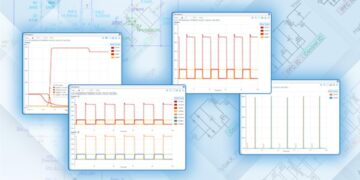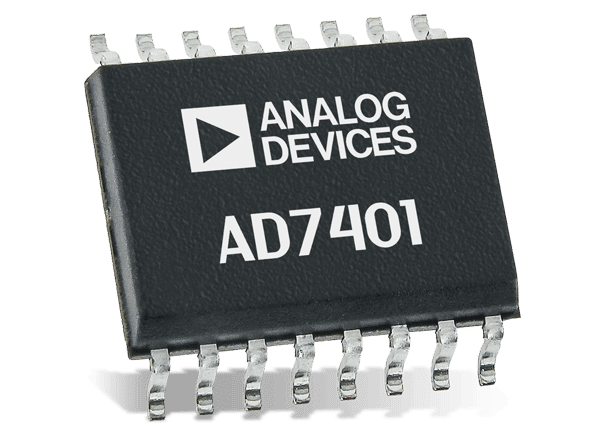
The AD7401AYRWZ sigma-delta modulator
A word thrown around often when discussing signal processing is noise. What exactly is noise? If you were standing at a busy intersection trying to have a conversation on your cell phone, you would say all other sounds not coming from your phone were noise. Similarly, for signal processing, noise can be defined as any signal that does not carry the information or data you want to receive. And regardless of the channel over which your desired signal is transmitted, there is always some noise to contend with.
Fortunately, there are devices whose primary function is to minimize this noise and enable you to receive the intended information or data. One such device is the AD7401AYRWZ sigma-delta modulator. Let’s explore this component in greater detail, after first taking a look at modulators and their importance.
Modulators and Why They Are Important
Modulators are essential elements in communication systems. Why? There are a number of reasons.
Modulator Functions
- Provide isolation between different signal types.
- Enable different information signal sources to be transmitted over the same frequency band.
- Allow devices with different signal characteristics to communicate.
Types of Modulators
Modulators are often classified based on the signal type they process and/or transmit. Common types are:
- Analog
Analog modulators typically alter the amplitude (AM) or frequency (FM) of a signal for transmission. For AM, a carrier signal frequency is used for transmission to which the receiver is tuned. After demodulation–stripping of the carrier–the information signal is recovered.
- Digital
Digital modulators transmit digital signals. Information or data is conveyed by varying the frequency, phase, or amplitude. For example, for phase shift keying (PSK) modulation, the phase may be changed to indicate an information signal transition from a 0 to a 1.
- Pulse
Pulse is a popular form of modulation where a pulse train is varied to convey the information or data. Often, the duration or pulse width (PWM) is the varying characteristic.
- Spread spectrum
Here, an information or data signal is ‘spread’ over a spectrum of frequencies. Lower power density transmission is an advantage of this modulation technique.
Of the types listed, pulse modulators are probably the most common, and one such type is the AD7401AYRWZ sigma-delta.
The AD7401AYRWZ Sigma-Delta Modulator
The AD7401A modulator is one of the many signal processing devices made by Analog Devices, Inc. The block diagram of this second order modulator is shown in the figure below.
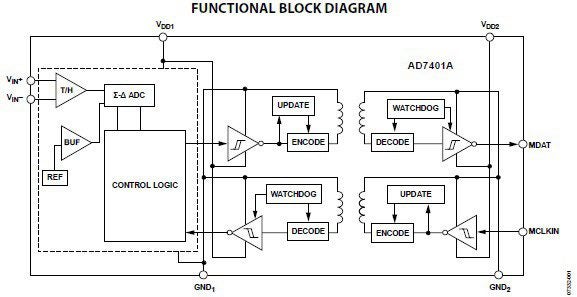
Block diagram of the AD7401AYRZW
As shown above, from the AD7401AYRWZ datasheet, the modulator contains dual paths, which enables differential signal processing, a control logic unit, and multiple op-amps (integrators). In addition to the two input signals (Vin+ and Vin-), the device also accepts a clock pulse and is supplied by two inputs (5V for supply 1 and 3V for supply 2). It is also noteworthy that the device contains transformer configurations that provide its excellent analog input isolation from digital output. This is just one of the features that make this device a common choice for many applications.
Features of the AD7401A
A summary of notable features for the AD7401A is listed below.
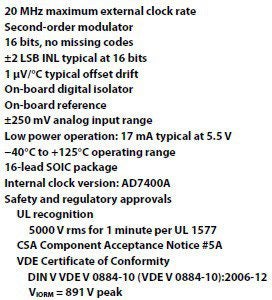
Features of the AD7401A modulator
As the list above indicates, the AD7401A has many important on-board features such as ADC isolation that utilizes Analog Devices iCoupler® technology, an internal clock, internal reference, a reasonably small offset drift due to temperature variation, and a good operational temperature range.
Applications and Alternatives
Due to its superior isolation capabilities, the AD7401A is often used as a replacement for opto-isolators. Analog Devices does make similar products–the AD7402, AD7403, and AD7405–which may be preferable for some applications, as shown in the table below.
| AD7401AYRWZ AND ALTERNATIVES | ||
| APPLICATIONS | AD7401A | AD7402/7403/7405 |
| AC Motor Control | ✔ | ✔ |
| Shunt Current Monitoring | ✔ | ✔ |
| DAQ | ✔ | ✔ |
| ADC Replacement | ✔ | ✔ |
| Opto-Isolator Replacement | ✔ | ✔ |
| Power and Solar Inverters | ✔ | |
| Wind Turbines | ✔ | |
As the table shows, when working with renewable energy systems, one of the alternatives should be utilized. Additionally, Analog Devices does offer a kit to expedite the application of the AD7401A. However, best practices for reference designs should be implemented to ensure the board meets your design objectives.
AD7401A Typical Circuit Operation
The AD7401A, AD7402, AD7403, and AD7405 are all actively produced components that are very similar. Therefore, the circuit below can be used as representative for all versions.
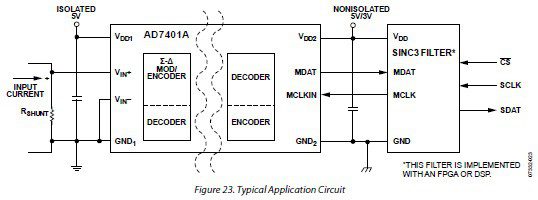
AD7401A circuit operation
As illustrated in the circuit above, it is important that a capacitor be installed between the power supply and ground for differential inputs to maximize signal fidelity. The same should be done between supply 2 and ground for the output, which should always be run through a filter–either external or as part of a DSP device–to achieve the desired frequency range.
Designing PCBAs With the AD7401AYRWZ
When designing boards that utilize the AD7401AYRWZ, there are two options. The more difficult of these is to create your schematic and PCB layout from scratch, which requires that you utilize information from the datasheet.
Using the AD7401AYRWZ Datasheet
In order to design a custom PCBA using the AD7401AYRWZ datasheet, it is imperative to understand the pinout and functionality, shown below.
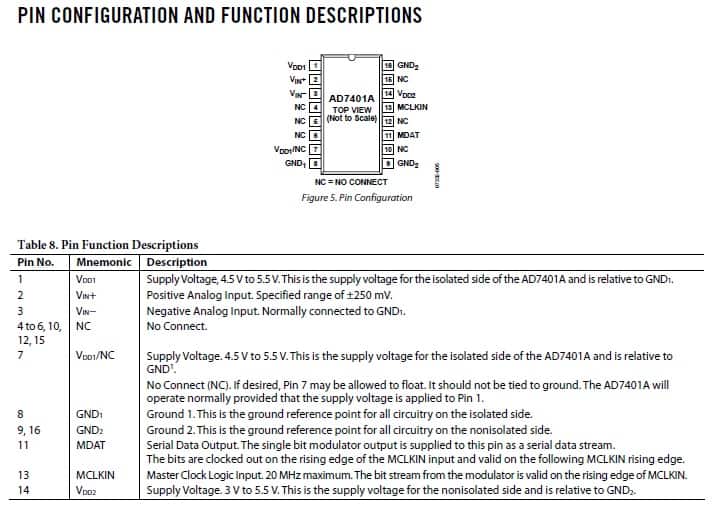
AD7401A Pinout and functions
As shown, the AD7401A does come in a standard 16-pin SOIC package. However, care must be taken to follow good PCB component footprint basics to avoid errors that may delay your board’s manufacturing.
Using the CAD Model
By far, the best and most efficient method of utilizing the AD7401AYRWZ–or one of its alternatives–is to utilize CAD models, as shown below, that can be easily uploaded into most PCBA design software packages and are preferred by CMs.
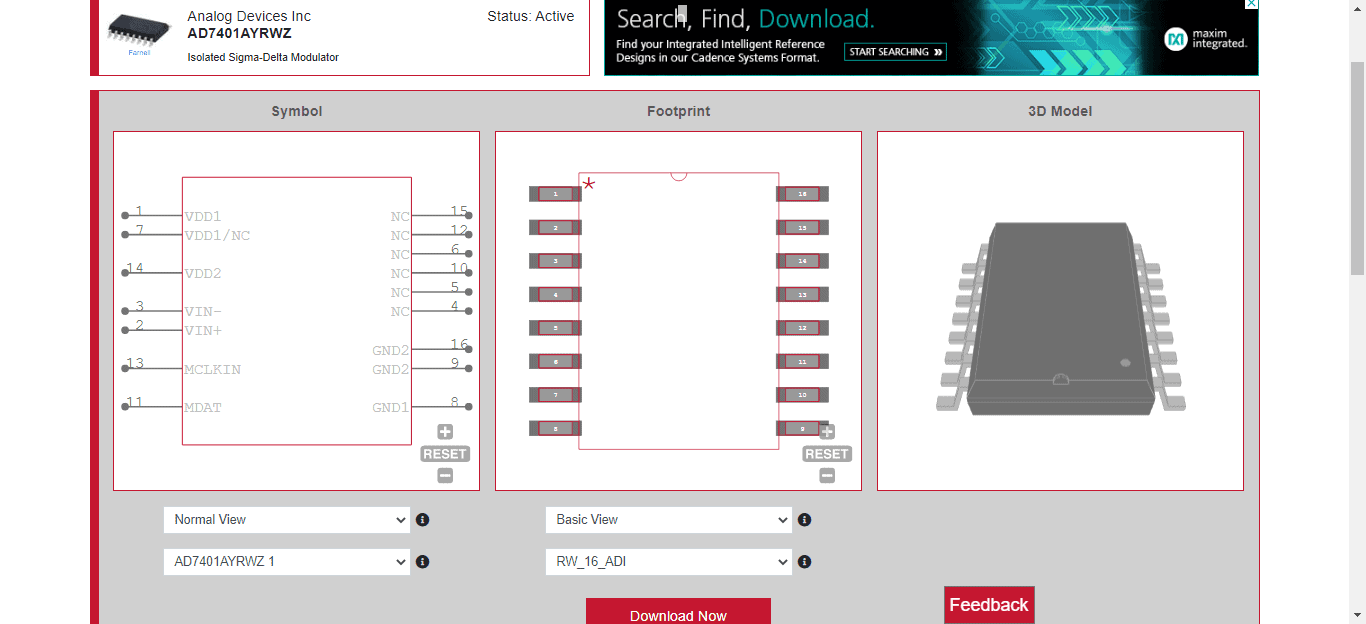
CAD models for the AD7401AYRWZ sigma-delta modulator
Not only are the above CAD models readily available online for use in your design, they can also be easily integrated into your component library management.
If you’re looking for CAD models for essential communication components, such as the AD7401AYRWZ sigma-delta modulator, Ultra Librarian helps by compiling all your sourcing and CAD information in one place.
Working with Ultra Librarian sets up your team for success to ensure streamlined and error-free design, production, and sourcing. Register today for free.


